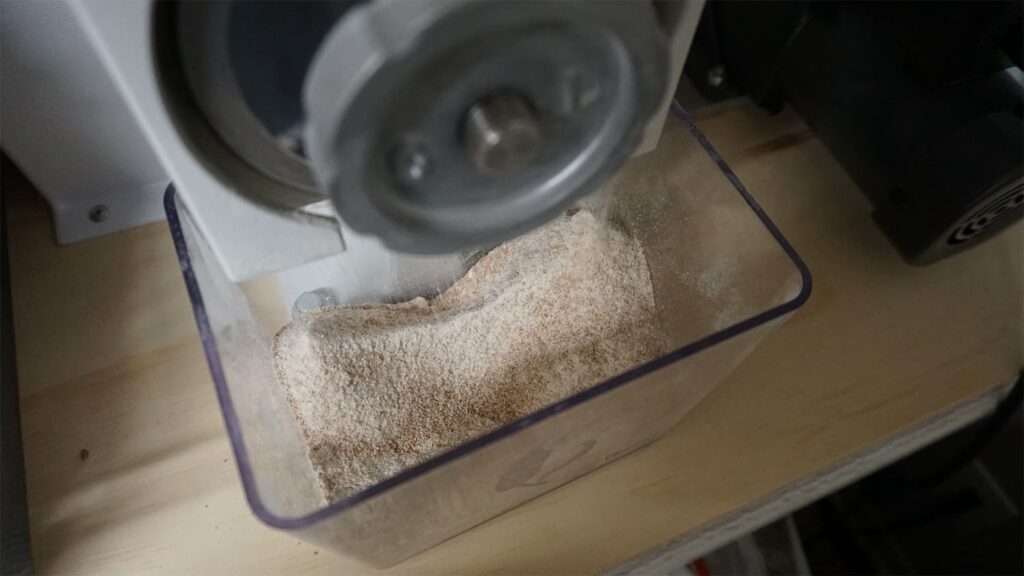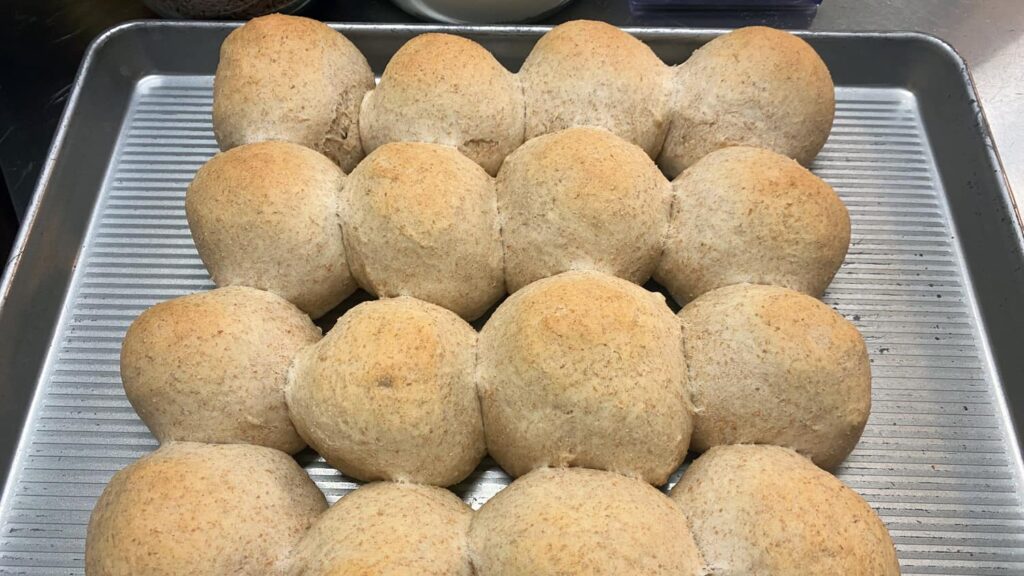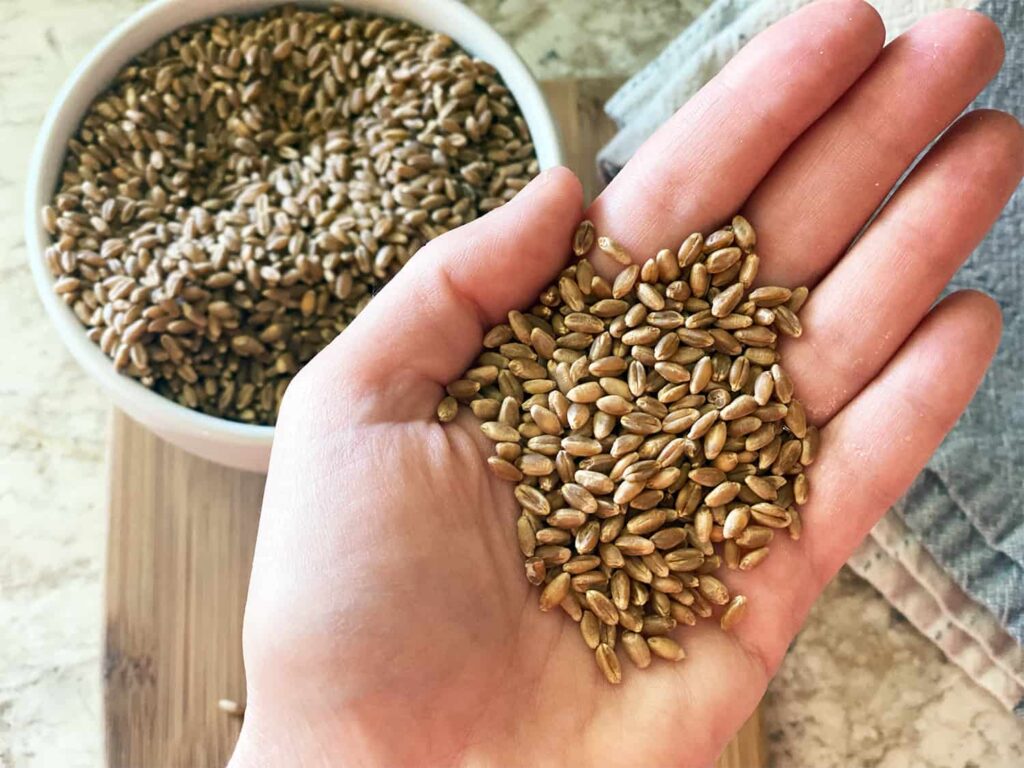When I dove into whole grain baking, red wheat was the one I started with–and it’s still one of my go-to favorites.
This versatile grain has a long history and can be found in different types, each with its unique flavor and nutritional benefits. Sourcing red wheat can be quite an adventure, whether you choose to buy it from a local farm or an online retailer, enabling you to experience this amazing whole grain in its purest form.
Milling your own red wheat at home can be quite rewarding, adding a personal touch to your culinary creations. On the other hand, pre-milled flour offers convenience and ease for those pressed for time. And whatever form of red wheat you choose, proper storage is essential to maintain its freshness and nutritional value. Luckily, there are plenty of creative ways to use red wheat flour in your recipes, allowing you to enjoy its unique flavor profile and impress your friends and family with your cooking prowess.
Red wheat: Origins and types
When it comes to wheat, there are several types available, and one of the most popular choices is hard red wheat.
Hard red wheat is one of the oldest types of wheat, having been cultivated for centuries by humans. It originates from the Fertile Crescent, an area spanning parts of the Middle East and Mediterranean regions. Hard red wheat is considered a “hard” wheat because it has a higher protein content than soft white wheat, making it well-suited for baking bread.
In contrast, soft wheat, including soft white wheat, is lower in protein and often used for pastries and cakes. The main difference between hard red wheat and hard white wheat lies in their color – red wheat has a reddish-brown hue, while white wheat is paler. Both hard varieties share a high protein content, but hard white wheat has a milder flavor compared to the more robust taste of hard red wheat.
When it comes to sourcing the wheat for your baking needs, you have two options: buying pre-milled flour or milling your own. I usually mill my own wheat berries at home, as it gives me control over the coarseness and freshness of the flour. Plus, it’s not difficult to find hard red wheat berries for purchase online or at a local store, making the process more convenient.

Storing your hard red wheat is relatively easy as well. If you’ve chosen to mill your own grains, keep the wheat berries in a cool, dry place, and they’ll last several years. If you’re using pre-milled flour, try to store it in an airtight container away from light – this will help retain its freshness and quality, though it won’t last quite as long as the whole berries.
Overall, hard red wheat is an excellent choice for those who enjoy making their own bread and other baked goods. Its impressive protein content and robust flavor make it a favorite among home bakers like me, and its storability ensures you can enjoy fresh, homemade bread any time you want.
Sourcing red wheat
Knowing where to buy good quality wheat is essential, as I’ve had some not-so-good experiences.
Wheat berries
I prefer to buy wheat berries, as they have a longer shelf life and give me the freedom to choose between milling them at home or using pre-milled flour. One of the hardest things to make sure of is that the berries you are buying are clean and free of debris.
You don’t want to eat dirty or dusty flour that is full of dirt or non-edible parts of the grain. And my getting a rock, even if it’s tiny, in your mill can ruin it.
Some of the best places to source hard red wheat:
- A local grain mill: The perks of buying from an organic mill include supporting local businesses, having fresher grains, and knowing where the wheat was grown. Unfortunately, I live in Texas and can easily buy my beef from a local rancher, but grain just doesn’t grow well here. Buying from a local farmer isn’t an option
- Specialty stores: I’m seeing more and more grain options popping up at my local HEB (a Texas -based grocery store) and also Walmart. Although I haven’t been able to find hard or soft red wheat at either chain, I did see a small bag at a local health food store. It’s a great way to try it and see if you like it before buying in bulk
- Online in bulk: This is how I currently buy my red wheat as I can get a bucket full of grains that can last my family months. I either use Azure Standard (affiliate link) which is delivered in “drops” once a month and Pleasant Hill Grain
Home milling versus pre-milled flour
Advantages of home milling
I love milling my own flour at home. First of all, the freshness is unbeatable. By grinding wheat berries right before baking, I ensure the flour retains its full nutritional value and flavor. Plus, I have total control over the coarseness of the grind. It’s great for experimenting with different textures in my baked goods!
Another reason I prefer home milling is the variety. I can easily mix and match various grains, like red wheat, to create customized flour blends. You can’t find this level of customizability with store-bought flour.
Pre-milled flour: pros and cons
Now, I know that not everyone has the time or equipment to mill their own flour, so let me talk about pre-milled flour. It definitely has some advantages. First, it’s convenient. You just buy the bag, and you’re good to go. No need to worry about buying a grain mill or finding storage space for buckets of wheat berries.
However, there are some downsides to pre-milled flour. The longer it sits on the shelf, the more nutrients it loses. So, you’re not getting the full nutritional benefits of whole wheat flour. Also, the options are limited compared to home milling. You usually only get a few choices of flours, and blending your own mixtures isn’t as simple.
Another thing to keep in mind is the storage of pre-milled flour. Just like with home-milled, it’s essential to store it in an airtight container away from heat and moisture to maintain maximum freshness.
Using red wheat in recipes
As someone who enjoys experimenting with ingredients in the kitchen, I’ve found that using red wheat can give a unique and wholesome flavor to various recipes. In this section, I’ll go over how to substitute red wheat flour, make bread using red wheat, and create pastries and baked goods like a pro.
Substituting red wheat flour
When it comes to swapping regular all-purpose flour with red wheat flour, it’s important to remember that red wheat flour is denser and might require some adjustments in recipes.
The substitution ratio is about 1:1, but when using red wheat flour, I usually add a little extra liquid to the recipe to ensure my dough doesn’t dry out. Additionally, you may notice a nuttier flavor and a slightly denser texture when using red wheat flour (which I love!).
Bread making with red wheat

Making bread with hard red wheat flour can provide a distinct flavor and texture. I typically use hard red wheat berries as the primary choice, grinding them into a flour.
Hard red wheat is perfect for creating rustic, whole-grain loaves, but it’s important to know that it usually produces denser bread, so I sometimes combine it with all-purpose or bread flour to balance the texture. This is a good way to introduce the bold flavor and dense texture of fresh-milled flour while not making the change so dramatic for your more sensitive eaters.
For bread making with hard red wheat flour, I stick to a basic ratio of 2 parts red wheat flour to 1 part all-purpose or bread flour. This blend ensures I get a lighter crumb and a more appealing crust. You can also do a ratio of 1 to 1 to make it even lighter.
Pastries and baked goods
When baking pastries or other goodies, I often work with red wheat flour. However, for lighter pastries and baked goods, I tend to use a blend of red wheat flour and all-purpose or pastry flour. Mixing in the latter helps create a tender crumb and delicate texture that complements the more robust flavor of red wheat.
For instance, if a recipe calls for 2 cups of all-purpose flour, I might use 1 cup of red wheat flour and 1 cup of all-purpose or pastry flour to achieve a balance between flavor and texture.
(Don’t forget to adjust the liquid ingredients in the recipe accordingly!)
Nutritional benefits and flavor profile
When it comes to nutrition, red wheat truly stands out. As I’ve learned, the bran and germ in red wheat are nutrient-packed, providing essential vitamins, minerals, and fiber that our bodies need. In fact, whole red wheat flour has more nutrients, vitamins, and fiber than white flour.
Milling your own red wheat at home is a great way to reap its full nutritional benefits. The fresher the flour, the higher the nutritional content and better flavor it brings to your cooking. Homemade flour makes a difference in my own baking, and the flavor is distinctively rich, with a nutty, wheaty taste that adds depth to my sourdough and yeasted breads.
Speaking of protein, hard red wheat, in particular, has a higher percentage of protein than soft wheat, making it an ideal choice for baking hearty breads that require a strong gluten structure. However, don’t let this fool you into thinking that red wheat is not versatile; it can be used not only in bread but also in pastries and various savory dishes.
In a 100 g (or 3.5 oz) serving of Hard Red Wheat, you’ll find:
| Nutrient | Amount per 100g |
|---|---|
| Calories | 327 kcal |
| Protein | 13.7 g |
| Total Fat | 1.5 g |
| – Saturated Fat | 0.3 g |
| – Monounsaturated Fat | 0.2 g |
| – Polyunsaturated Fat | 0.6 g |
| Carbohydrates | 71.2 g |
| Dietary Fiber | 12.2 g |
| Sugars | 0.4 g |
| Vitamins & Minerals | |
| – Calcium | 34 mg |
| – Iron | 3.9 mg |
| – Magnesium | 138 mg |
| – Phosphorus | 346 mg |
| – Potassium | 405 mg |
| – Sodium | 2 mg |
| – Zinc | 2.9 mg |
| – Vitamin C | 0 mg |
| – Thiamin (B1) | 0.4 mg |
| – Riboflavin (B2) | 0.1 mg |
| – Niacin (B3) | 6.4 mg |
| – Vitamin B6 | 0.3 mg |
| – Folate (B9) | 38 μg |
| – Vitamin E | 0.8 mg |
| – Vitamin K | 1.9 μg |
Storing red wheat and flour
Wheat berries storage
To maintain their freshness and ensure a long shelf life, I keep them in a cool, dry, and dark place. A tightly sealed container, like a food-grade bucket (which is what my wheat berries come in when I order them from a bulk supplier) or a glass jar (I usually use a 1-gallon mason jar), works best for me.
I’ve heard that storing my red wheat berries in this way can give them a shelf life of up to 30 years.
Flour storage
When it comes to flour storage, I’ve learned that implementing a few key techniques can make a difference. For both red wheat whole wheat flour and all-purpose flour, it’s essential to keep the flour away from heat, moisture, and direct sunlight.
Here’s how I store my flour for optimal freshness:
- Short-term storage: For everyday use, I keep my flour in an airtight container in a cool, dry place–easily accessible on my kitchen counter. This has helped me to maintain the flour’s quality for up to a year
- Long-term storage: If I need to store my red wheat flour for an extended period, I usually put it in the freezer, packed in a sealed container or a heavy-duty plastic bag. I only keep all-purpose flour long-term because fresh-ground whole wheat flour has a shorter shelf life due to the presence of natural oils in the wheat germ
- Longer-term storage: I have also used food-grade buckets, lined with a bucket-sized mylar bag, to store all-purpose flour. I will add oxygen absorbers and then seal the mylar bags with my hair straighter–it’s worked out great
Boosting red wheat’s nutrition
Soaking and sprouting
The more I learn about baking with red wheat the more I’ve learned about soaking and sprouting them to bring out its nutritional benefits.
Soaking red wheat berries for up to 12 hours in water helps break down tough outer layers, making nutrients like fiber and antioxidants more accessible. After soaking, let the wheat berries sprout for a day or two. (What is sprouting? It’s literally letting a tiny little green sprout pop out of the berry! You are transforming the grain from a seed to a plant, making it much easier on your gut!)
Sprouting triggers enzymes that help break down phytic acid, which can inhibit nutrient absorption. This process not only enhances the nutritional value of red wheat but also gives it a nice, crunchy texture, perfect for salads and snacks or even for baking.
If you want to grind the sprouted berries, just let them dry back out after sprouting and grind them in your mill like normal!
Combining with other ingredients
Incorporating red wheat into my recipes doesn’t just add texture, it also boosts the meal’s overall nutrition. I love mixing red wheat with other ingredients like fruit, spices, and even white wheat berries. These combinations not only create new flavors but also provide an extra punch of nutrition.
For example, I often mix red and white wheat berries to create a blend. I find that white wheat berries are milder in flavor, allowing red wheat’s earthy tones to shine. Combining the two varieties also means I’m receiving a wider range of nutrients and antioxidants.
When it comes to incorporating fruit and spices, the possibilities are endless. Adding blueberries or raspberries can increase the overall antioxidant content of a bread. And it’s not just fruit – combining red wheat with spices like cinnamon or nutmeg can significantly change the flavor profile while also providing extra vitamins and minerals.
Frequently asked questions
Where can I buy red wheat for home milling?
I usually buy my red wheat berries from local health food stores or online retailers in bulk. I either use Azure Standard (affiliate link) which is delivered in “drops” once a month and Pleasant Hill Grain. I also have been really happy with Bob’s Red Mill’s red wheat.
Milling vs. pre-milled: which is better?
As I’ve experimented with both, I found that there are pros and cons to milling at home and buying pre-milled flour. Milling your own red wheat allows you to enjoy the freshest and most nutrient-dense flour. It also gives you control over the fineness of the grind. On the other hand, pre-milled flour is more convenient and has a longer shelf life. It all depends on what’s more important to you: freshness and control, or convenience and longer storage.
What’s the best use for red wheat flour?
In my experience, red wheat flour works best for whole wheat bread, as it has a stronger gluten structure and higher protein content than white wheat. This results in a denser texture and deeper, nuttier flavor. It’s also wonderful for homemade pizza crusts, and you can even use it in pancakes and cookies for a heartier taste.
How should I store freshly milled red wheat flour?
For the best results, I store my freshly milled red wheat flour in an airtight container, away from heat, light, and moisture. A cool, dark pantry is ideal, but if your kitchen gets too warm or you don’t plan on using the flour within a few days, it’s best to refrigerate or freeze it for longer storage.
How long does milled red wheat flour last?
At room temperature, freshly milled red wheat flour is best used within three days of grinding. If refrigerated, it can last up to a week, and if frozen, it can last up to six months. Just make sure to properly seal the container to prevent moisture and unwanted smells from affecting the quality of your flour.
Which wheat variety is ideal for all-purpose flour?
When I need an all-purpose flour, I often choose hard white wheat, as it has a milder flavor and lighter texture than red wheat. However, you can also blend different wheat varieties like hard red, soft white, and durum wheat to create a customized all-purpose flour that suits your baking needs.








